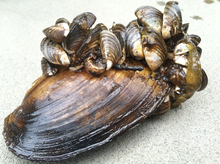Quick facts
Zebra mussel is a prohibited invasive species. It is illegal to possess, import, purchase, transport, or introduce these species (including hybrids or cultivars) except under a permit or statutory exemption. Transport directly to MN DNR in a sealed container for identification or reporting purposes is permitted.
- Zebra mussels are filter feeders, reducing available food for other animals.
- Their feeding habits can increase water clarity, increasing the potential for aquatic plant growth.
- Zebra mussels attach to any hard surface, including native mussels which can prevent their ability to feed and reproduce.
Zebra mussels should be reported. The Minnesota Department of Natural Resources provides detailed recommendations for reporting invasive species.
How to identify zebra mussels
- Zebra mussels (Dreissena polymorpha) adults are one fourth to one and a half inches long and have D-shaped shells with a pointed hinge.
- They often have alternating yellow/tan and brownish-colored stripes, but coloration is highly variable and stripes may be lacking altogether.
Life cycle
- Female zebra mussels can produce 100,000 to 500,000 eggs per year.
- These develop into microscopic, free-living larvae (called “veligers”) and begin to form shells.
- After two to three weeks, the veligers settle and attach to any firm surface using tiny fibers (byssal threads).
Reviewed in 2019



